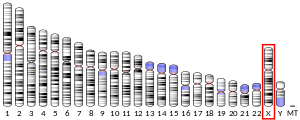MXRA5
Matrix-remodelling associated 5 is a protein in humans that is encoded by the MXRA5 gene.[3]
| MXRA5 | |||||||||||||||||||||||||
|---|---|---|---|---|---|---|---|---|---|---|---|---|---|---|---|---|---|---|---|---|---|---|---|---|---|
| Identifiers | |||||||||||||||||||||||||
| Aliases | MXRA5, matrix remodeling associated 5 | ||||||||||||||||||||||||
| External IDs | OMIM: 300938 HomoloGene: 56704 GeneCards: MXRA5 | ||||||||||||||||||||||||
| |||||||||||||||||||||||||
| |||||||||||||||||||||||||
| Orthologs | |||||||||||||||||||||||||
| Species | Human | Mouse | |||||||||||||||||||||||
| Entrez |
| ||||||||||||||||||||||||
| Ensembl |
| ||||||||||||||||||||||||
| UniProt |
| ||||||||||||||||||||||||
| RefSeq (mRNA) |
| ||||||||||||||||||||||||
| RefSeq (protein) |
| ||||||||||||||||||||||||
| Location (UCSC) | Chr X: 3.31 – 3.35 Mb | n/a | |||||||||||||||||||||||
| PubMed search | [2] | n/a | |||||||||||||||||||||||
| Wikidata | |||||||||||||||||||||||||
| |||||||||||||||||||||||||
Function
This gene encodes one of the matrix-remodelling associated proteins. This protein contains 7 leucine-rich repeats and 12 immunoglobulin-like C2-type domains related to perlecan. This gene has a pseudogene on chromosome Y.[3]
Clinical relevance
Mutations in this gene have been seen frequently mutated in cases of non-small cell lung carcinoma.[4]
gollark: I think typically you just show that you can convert a language which is known to be capable of running DFAs or whatever into your one.
gollark: Oh, hi new person.
gollark: Technically no. Memory is finite.
gollark: Quick, everyone read an extremely complex maths book on nonstandard analysis.
gollark: Clearly we should standardize on a good definition of infinite things here?!
References
- GRCh38: Ensembl release 89: ENSG00000101825 - Ensembl, May 2017
- "Human PubMed Reference:". National Center for Biotechnology Information, U.S. National Library of Medicine.
- "Entrez Gene: Matrix-remodelling associated 5". Retrieved 2012-07-24.
- Xiong D, Li G, Li K, Xu Q, Pan Z, Ding F, Vedell P, Liu P, Cui P, Hua X, Jiang H, Yin Y, Zhu Z, Li X, Zhang B, Ma D, Wang Y, You M (Sep 2012). "Exome sequencing identifies MXRA5 as a novel cancer gene frequently mutated in non-small cell lung carcinoma from Chinese patients". Carcinogenesis. 33 (9): 1797–805. doi:10.1093/carcin/bgs210. PMC 3514907. PMID 22696596.
Further reading
- Chondrogianni N, de C M Simoes D, Franceschi C, Gonos ES (2004). "Cloning of differentially expressed genes in skin fibroblasts from centenarians". Biogerontology. 5 (6): 401–9. doi:10.1007/s10522-004-3188-1. PMID 15609104.
- Fu GK, Wang JT, Yang J, Au-Young J, Stuve LL (Jul 2004). "Circular rapid amplification of cDNA ends for high-throughput extension cloning of partial genes". Genomics. 84 (1): 205–10. doi:10.1016/j.ygeno.2004.01.011. PMID 15203218.
- Zou TT, Selaru FM, Xu Y, Shustova V, Yin J, Mori Y, Shibata D, Sato F, Wang S, Olaru A, Deacu E, Liu TC, Abraham JM, Meltzer SJ (Jul 2002). "Application of cDNA microarrays to generate a molecular taxonomy capable of distinguishing between colon cancer and normal colon". Oncogene. 21 (31): 4855–62. doi:10.1038/sj.onc.1205613. PMID 12101425.
This article incorporates text from the United States National Library of Medicine, which is in the public domain.
This article is issued from Wikipedia. The text is licensed under Creative Commons - Attribution - Sharealike. Additional terms may apply for the media files.

